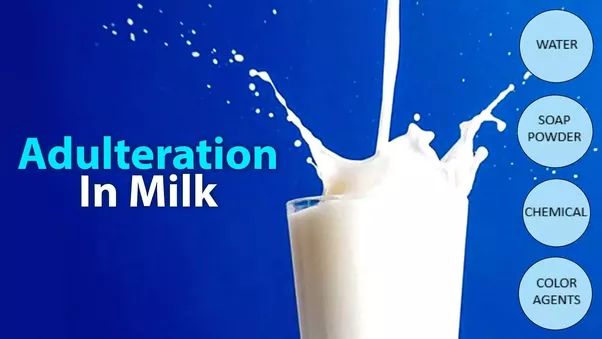“This Article is developed in lieu of General Awareness to Common People, the article is developed in accordance with Authors Personal experience and Adulterants declared by FSSAI and USFDA. The identification and conformity are just to check the presence, further confirmation can be followed by Approved Food testing Laboratories (FSSAI).”
Adulteration of food Cheats the consumer and poses a serious risk to health. A common consumer may not have sufficient knowledge about purity and quality of food articles he consumes. Mere visual inspection does not serve the purpose especially when adulteration has assumed high degree of sophistication.
Milk is the basic necessity of our household, especially among children. The poor quality and adulteration in milk may lead to malnutrition for which we are still emerging.
1. The first adulterant is Water
Water is easily available and can be mixed easily. However, the quality of water affects the quality of the milk. The intended purpose of using water is to increase the quantity of milk.
Possible Quality Effects
- The nutrient profile is decreased.
- If water is contaminated, milk will also be contaminated
Way of Detection
The presence of water can be by putting a drop of milk on a polished slanting surface. The drop of pure milk either or flows lowly leaving a white trail behind it, whereas milk adulterated water will flow immediately without leaving a mark.
2. Starch
Starch is a soft, white, tasteless powder that is insoluble in cold water, alcohol, or other solvents. Dietary starch is present in many staple foods, such as maize, rice, wheat, potatoes, cassava, barley, rye, taro, yams, etc. It is also present in various food products such as cereals, noodles, pancakes, bread, pasta, etc.
Possible Quality Effects
- The nutrient profile is decreased.
- Starches are linked to a higher risk of diabetes, heart disease and weight gain. In addition, they can cause blood sugar to spike rapidly and then fall sharply. This is especially important for people with diabetes and prediabetes, since their bodies can't efficiently remove sugar from the blood.
Way of Detection
- Add a few drops of tincture of Iodine or Iodine solution. Formation of blue color indicates the presence of starch.
- In Khoa and its Products - Boil a small quantity of sample with some water, cool and add -a few drops of Iodine solution. Formation of blue color indicates the presence of starch.
- In Chhena or Panner - Boil a small quantity of sample with some water, cool and add a few drops of Iodine solution. Formation of blue color indicates the presence of starch.
3. Urea
Urea is the major constituent of the urine and the principal means for disposal of nitrogen derived from amino acid metabolism. Specialized phloretin-inhibitable urea transporters are expressed in kidney medulla and play a central role in urea excretion and water balance.
Urea is a source of Nitrogen, an essential nutrient crucial for crop growth and development. Urea is the most important nitrogenous fertilizer in the country because of its high N content (46%N). It also has industrial applications such as the production of plastics and as a nutritional supplement for cattle
Possible Quality Effects
- The nutrient profile is decreased.
- Dilution
Way of Detection
Take a teaspoon of milk in a test tube. Add ½ teaspoon of soybean or arhar powder. Mix up the contents thoroughly by shaking the test tube. After 5 minutes, dip a red litmus paper in it. Remove the paper after ½ a minute. A change in color from red to blue indicates the presence of urea in the milk.
4. Vanaspati
Vanaspati is a fully or partially hydrogenated vegetable cooking oil, often used as a cheaper substitute for ghee and butter. In India, vanaspati ghee is usually made from palm oil. Hydrogenation is performed using a catalyst known as "supported nickel catalyst", in reactors at low-medium pressure (3-10 bar).
It is used to increase the fat content and to give a creamy texture to the milk when boiled. It is also found in sweet curd.
Possible Quality Effects
- The nutrient profile is decreased.
- Fat content is increased
Way of Detection
- Take 3 ml of milk in a test tube. Add 10 drops of hydrochloric acid. Mix up one teaspoonful of sugar. After 5 minutes, examine the mixture. The red coloration indicates the presence of vanaspati in the milk.
- Take1 teaspoon full of curd in a test tube. Add 10 drops of hydrochloric acid. Mix up the contents shaking the test tube gently. After 5 minutes, examine the mixture. The red colouration indicates the presence of vanaspati in the curd.
5. Formalin
It is a clear aqueous solution of formaldehyde and methanol used especially as a preservative. Formaldehyde is a naturally occurring organic compound with the formula CH₂O. The pure compound is a pungent-smelling colorless gas that polymerises spontaneously into paraformaldehyde, hence it is stored as an aqueous solution, which is also used to store animal specimens. It is the simplest of the aldehydes.
Formalin enhances the life of milk and thus is added for preservation purpose.
Possible Quality Effects
- The nutrient profile is decreased.
- The shelf life is increased for synthetic milk.
Way of Detection
Take 10 ml of milk in a tests tube and add 5 ml of con sulphuric acid from the sides of the wall without shaking. If a violet or blue ring appears at the intersection of two layers then it shows presence of formalin.
6. Detergent
Detergent is a surfactant or a mixture of surfactants with cleansing properties when in dilute solutions. However, conventionally, detergent is used to mean synthetic cleaning compounds as opposed to soap (a salt of the natural fatty acid), even though soap is also a detergent in the true sense.
A higher proportion of unpackaged milk samples contained detergents and ammonium sulphate. Milk adulterated with detergents is known to cause food poisoning and gastrointestinal complications.
Possible Quality Effects
- The nutrient profile is decreased.
- Dilution
Way of Detection
Shake 5-10 ml. of sample with an equal amount of water lather indicates the presence of detergent.
7. Synthetic Milk
Synthetic milk is not milk but an artificial imitation of natural milk with a high degree of adulteration to increase the volume of milk and thereby the profit. Main components of synthetic milk are water, pulverized detergent or soap, sodium hydroxide, vegetable oil, salt and urea.
Way of Detection
- Synthetic milk has a bitter after taste, gives a soapy feeling on rubbing between the fingers and turns yellowish on heating.
- The milk can easily be tested by Urease strips (available in the Medical stores) because Synthetic milk is devoid of protein.
- Milk does not contain glucose /invert sugar, if test for glucose with urease strip found positive. It means milk is adulterated.
- If it is made synthetically by adding while color water paint. Oils, alkali, urea and detergent etc. Glucose, inverted sugar syrup is added in milk to increase the consistency and test.
8. Ghee, cottage cheese, condensed milk, khoa, milk powder etc, are Adulterated with Coal Tar Dyes
Ghee is primarily adulterated by vegetable/plant oils and animal body fats. Adulterants whose physical texture resembles that of ghee were preferred, as they are difficult to detect visually. Hydrogenated vegetable oils (dalda) are considered as the most suitable material for adulteration.
Coal tar dyes are artificial coloring agents made by combining various aromatic hydrocarbons like toluene, xylene, benzene, which are obtained from the distillation of bituminous coal. Coal tars are also made from petroleum distillates. Coal tar is a brown or black liquid of extremely high viscosity.
Way of Detection
Add 5 ml of dil. H2SO4 or conc. HCL to one teaspoon full of melted sample in a test tube. Shake well. Pink color (in case of H2SO4) or crimson color (in case of HCl) indicates coal tar dyes. If HCl does not give color dilute it with water to get the color.
9. Blotting Paper
Blotting paper, called bibulous paper, is a highly absorbent type of paper or other material. It is used to absorb an excess of liquid substances (such as ink or oil) from the surface of writing paper or objects.
It is primarily used in Rabdi,
Way of Detection
Methods for Detection of common adulterants in Sweetening Agents
Methods for Detection of common adulterants in Food Grain & Their Products
Methods for Detection of common adulterants in Spices
Methods for Detection of common adulterants in Common Kitchen Items
Courtesy
Food Adulteration Act, FSSAI, Image courtesy ByJus

